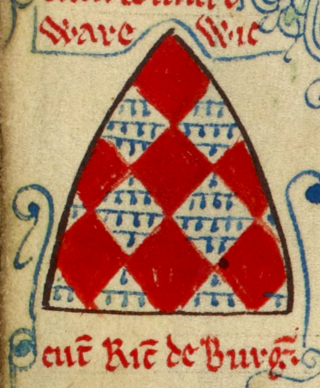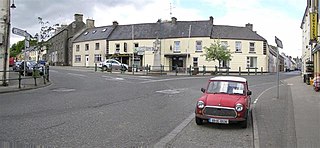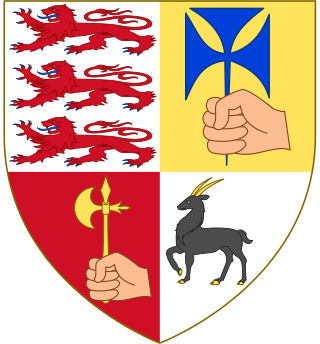
County Tipperary is a county in Ireland. It is in the province of Munster and the Southern Region. The county is named after the town of Tipperary, and was established in the early 13th century, shortly after the Norman invasion of Ireland. It is Ireland's largest inland county and shares a border with eight counties, more than any other. The population of the county was 167,895 at the 2022 census. The largest towns are Clonmel, Nenagh and Thurles.

Nenagh is the county town of County Tipperary in Ireland. Nenagh used to be a market town, and the site of the East Munster Ormond Fair.

Dromineer is a small village and townland in County Tipperary, Ireland. It is on the shores of Lough Derg, 8 km north-west of Nenagh on the R495 road. It is also a civil parish in the historical barony of Ormond Lower. Historic documents describe the places as "Dromynnyre"; the earliest form of the name dating from 1302 was Dromynwyr.

Lough Derg, historically Lough Dergart, is a freshwater lake in the Shannon River Basin, Ireland. It is the third-biggest on the island of Ireland and the second largest lake in the Republic of Ireland.

Richard Mór de Burgh, 1st Lord of Connacht, was an Anglo-Norman aristocrat who was Seneschal of Munster and Justiciar of Ireland (1228–32).

Puckane, officially Puckaun, is a village in County Tipperary, Ireland. It is also a parish in the Roman Catholic Diocese of Killaloe. The village is located 10 km north of Nenagh along the R493 and close to Lough Derg and Dromineer. It had a population of 250 people as of the 2016 census.

St Patrick's Purgatory is an ancient pilgrimage site on Station Island in Lough Derg, County Donegal, Ireland. According to legend, the site dates from the fifth century, when Christ showed Saint Patrick a cave, sometimes referred to as a pit or a well, on Station Island that was an entrance to Purgatory. Its importance in medieval times is clear from the fact that it is mentioned in texts from as early as 1185 and shown on maps from all over Europe as early as the fifteenth century. It is the only Irish site designated on Martin Behaim's world map of 1492.

Portumna is a market town in the south-east of County Galway, Ireland, on the border with and linked by a bridge to County Tipperary. The town is located to the west of the point where the River Shannon enters Lough Derg. This historic crossing point over the River Shannon between counties Tipperary and Galway has a long history of bridges and ferry crossings. On the south-western edge of the town lie Portumna Castle and Portumna forest park.

Pettigo, also spelt Pettigoe, is a small village and townland on the border of County Donegal, Republic of Ireland, and County Fermanagh, Northern Ireland. It is bisected by the Termon River which is part of the border between the Republic of Ireland and Northern Ireland.

Terryglass is a village in County Tipperary, Ireland. The small town is located on the R493 regional road on the north-eastern shore of Lough Derg near where the River Shannon enters the Lough. It is a civil parish in the historical barony of Ormond Lower. It is also an Ecclesiastical parish in the Roman Catholic Diocese of Killaloe,. Terryglass won the Irish Tidy Towns Competition in 1983 and 1997.

Belcoo ( is a small village and townland in County Fermanagh, Northern Ireland, 10 miles from Enniskillen. It is on the County Fermanagh/County Cavan border beside the village of Blacklion in the Republic of Ireland. It had a population of 540 in the 2011 Census. It is situated within the Fermanagh and Omagh District.
Columba of Terryglass (Colum) was the son of Ninnidh, a descendant of Crinthainn, King of Leinster. Columba was a disciple of St. Finnian of Clonard. He was one of the Twelve Apostles of Ireland.
Castlebawn is a 16th-century tower house, in County Clare, Ireland. It is on a small island on Lough Derg on the River Shannon, it is connected to the shore of Bealkelly by a man-made causeway. It was built by the McNamaras about 1540, severely damaged in 1827, but is now restored although public access is not permitted to the castle.
Lorrha is a small village at the northern tip of County Tipperary, Ireland. Ledewich described village as 'Larah' which is the common name for the talk-motes, mote hills etc. P. Dixon Hardy M.R.I.A. describes it as 'Loragh'

Áed Ua Crimthainn, also called Áed mac Crimthainn, was abbot and coarb of Terryglass, near Lough Derg in County Tipperary, Ireland. He was the principal scribe of the Book of Leinster, the Book of Oughaval, an important Middle Irish medieval illuminated manuscript, and is also believed to have been its sole compiler.
Iffa and Offa West is a barony in County Tipperary, Ireland. This geographical unit of land is one of 12 baronies in County Tipperary. Its chief town is Cahir. The barony lies between Clanwilliam to the north-west, Middle Third to the north-east and Iffa and Offa East to the east. The area is currently administered by Tipperary County Council. The barony is within the geographic remit of the Roman Catholic Diocese of Waterford and Lismore.
Slevoir is a townland in the Barony of Ormond Lower, County Tipperary, Ireland. It is located in the civil parish of Terryglass overlooking Slevoir Bay, the most north-eastern part of Lough Derg

The McGrath family is an Irish clan. The name is derived from the Gaelic Mac Craith, recorded in other written texts as Mag Craith, Mag Raith and Macraith, including the Annals of the Four Masters and the Annals of Ulster. McGrath is a surname of ancient Irish origin, and is borne by the descendants of a number of septs, each with a common origin in the Kingdom of Thomond, a kingdom that existed before the Norman invasion and was located in north Munster.

Lough Derg Yacht Club is a boat club based in the lakeside village of Dromineer in County Tipperary, Ireland. Founded in 1835, it is one of the world's oldest yacht clubs. The club is based in a modern clubhouse on the east shore of Lough Derg.
Kilfadda is a townland in the Barony of Ormond Lower, County Tipperary, Ireland. It is located in the civil parish of Aglishcloghane close to the town of Borrisokane.

















